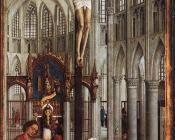托马斯·沃特曼·伍德
Thomas Waterman Wood
美国画家 1823-1903 , 所有托马斯·沃特曼·伍德的作品
Thomas Waterman Wood (November 12, 1823 - April 14, 1903) was an American painter born in Montpelier, Vermont. Thomas Waterman Wood's father, John Wood, came to Montpelier from Lebanon, New Hampshire in 1814. The Wood family was of Puritan stock, and it was from Lebanon that John Wood, the father of the artist, married his wife Mary Waterman. She was described as having lived a simple, pious, good-natured and industrious life. John Wood and his brother Cyrus were partners in a cabinet making business, the partnership concluding with the death of Cyrus in 1840. John's other brother, Zenas, lived to be 84 years of age. John Wood was a vigorous citizen, active in his times, the captain of an artillery company and for a long time, a deacon in the First Congregational Church. During Wood's youth, Montpelier was not likely to inspire a man to paint. It was a small town of practical people, lacking in the means of art culture and instruction in art. The hills and valleys, however, were beautiful, filled at all seasons with a wonderful light, and these had and continued to have for Wood an inspiration and influence throughout his life. While he lacked artistic surroundings in his youth, he also had the acquaintance of great contemporaries, Prentiss, Upham, Spaulding, Peck, Reed, Walton, Jewett, Langdon, Merrill, Dewey, Thompson, Baileys, Heaton, Lord, Lamb and many more besides, who left notable records in Congress, on the bench, at the bar, in theology, finance, legislation, party politics and in the bibliography of Vermont. These neighbors of his were good, strong men, whose characters and excelling work influenced the youth of Wood as also his conceptions of a strong art, as was evidenced in later years by much of his best work. Before the introduction of daguerreotypes Montpelier was accustomed to receive an occasional visit from some peripatetic portrait painter and it was such a painter who first influenced Wood and started him in his career. The painter has been described as a "harum-scarum" character, but also as a "dashing painter", who was able to seize quickly and firmly upon a likeness. There was also a friend, John C. Badger, who brought from Boston tubes of oil colors, brushes, palettes and some books about art. With these in hand the boys began with enthusiasm to develop their resources. There remains nothing of these first efforts; but when the furniture shop of John Wood was destroyed by fire in 1875 there could yet be seen on its plastered walls a number of figure pictures, drawn with dry paints, a sort of rude pastel.托马斯沃特曼伍德 - Thomas Waterman Wood



